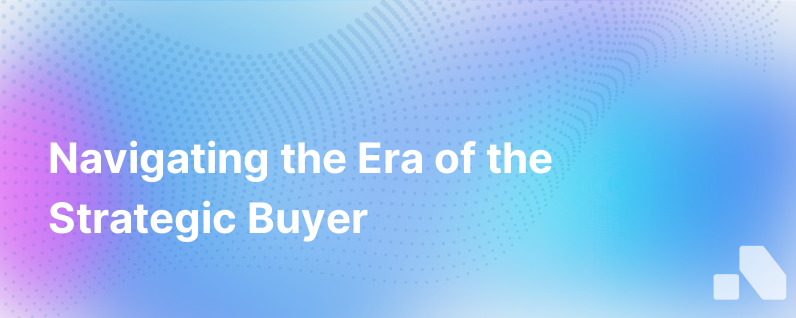The Rise Of The Strategic Buyer
Published on September 10, 2023 by David Zhang
In the dynamic arena of today’s global market, a transformative shift is occurring. The buyer landscape is evolving, with a new protagonist emerging onto the scene: the Strategic Buyer. This new player brings to the table an amalgamation of savvy analytical skills, a forward-thinking mindset, and a deeply ingrained strategic approach to purchasing decisions. Gone are the days when transactional buying - driven by short-term needs and reactively responding to problems - ruled the roost. Instead, we are witnessing the rise of a new era – the era of the Strategic Buyer.
Understanding the Strategic Buyer
Strategic Buyers are not accidental purchasers; they are well-informed, meticulous planners who look beyond the immediate need or lowest price point. They're concerned with the overall impact of their purchase on the organization’s objectives and long-term goals. They see their decisions as pivotal cogs in a larger corporate mechanism and are therefore more holistic in their approach.
But what factors are driving this transformation?
The Digital Information Age
The internet has been the great equalizer, providing a wealth of information to all tiers of users. Buyers now have immediate access to vendor reviews, market reports, product comparisons, and peer recommendations. The Strategic Buyer uses this deluge of data to make informed decisions that can positively influence their company's long-term trajectory rather than basing decisions on just cost or convenience.
The Shift from Goods to Services and Solutions
As economies worldwide become increasingly service-oriented, the emphasis on product features and benefits has migrated to the experiences and solutions that these goods or services facilitate. The Strategic Buyer is acutely aware of how offerings integrate into broader business processes, enhance productivity, or drive innovation.
The Heightened Complexity of Solutions
Technology and service convergence means that many products are now part of complex ecosystems. The Strategic Buyer must navigate these intricacies, ensuring that any procurement decision aligns with existing systems and anticipates future integrations or upgrades.
Behaviors of the Strategic Buyer
The modus operandi of the Strategic Buyer centers around several key behaviors:
Long-term Vision
Strategic Buyers look to the horizon, not just the ground beneath their feet. Their decisions are influenced by how purchases align with long-term organizational initiatives like digital transformation, sustainability, and global expansion.
Ecosystem Thinking
They understand that procurement is about more than just obtaining a tool or service – it's about how these acquisitions fit into the broader business ecosystem, including compatibility with current systems and processes.
Value over Price
While cost is always a consideration, Strategic Buyers are more concerned with value -- the ROI that a purchase can deliver in terms of efficiency, innovation, and competitiveness.
Relationship Focus
Strategic Buyers invest in building relationships with vendors. They're not interested in one-off transactions but in partnerships that provide ongoing value and adapt to changing needs.
Cross-Functional Collaboration
Understanding that purchases have interdepartmental implications, Strategic Buyers often collaborate with stakeholders across the business to gain insights and ensure alignment with broader organizational objectives.
Engaging with the Strategic Buyer
The rise of the Strategic Buyer has significant implications for sales and marketing strategies. Traditional sales tactics, which often emphasize product features and pricing, are less effective. Instead, engaging with the Strategic Buyer requires an evolved approach:
Consultative Selling
Sales teams need to become knowledgeable consultants, combining deep industry insights with a clear understanding of the buyer’s business challenges and opportunities.
Value-Based Messaging
Messaging must shift from product-centric to value-centric, highlighting how solutions can drive the buyer’s business forward and address strategic goals.
Personalized Engagement
Strategic Buyers expect interactions to be tailored to their unique needs and challenges. Generic pitches won’t cut it; personalization is key.
Continuous Relationship Building
The relationship doesn’t end with the sale. Instead, post-purchase engagement and support are critical for nurturing a lasting relationship with the Strategic Buyer.
Utilizing Data & Insights
Analytics play a pivotal role in understanding and predicting the needs and behaviors of Strategic Buyers, helping tailor interactions and offerings accordingly.
Conclusion
The rise of the Strategic Buyer heralds a new dawn in B2B sales – a shift from transactional selling to a strategic partnership model. Organizations must adapt their methodologies, harness the potential of data, and approach sales and marketing as a consultative service that emphasizes long-term value creation over immediate gains.
In this era, understanding and responding to the evolving needs of Strategic Buyers is not just advantageous — it’s imperative for those who wish to remain competitive and relevant. The Strategic Buyer isn’t a fading trend; they are the vanguard of a fundamental evolution in B2B procurement. Organizations that can successfully engage with this new breed of buyer will be well-positioned for success in the business landscapes of tomorrow.